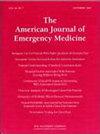Ultrasound accuracy in acute diverticulitis: A systematic review and Meta-analysis
IF 2.7
3区 医学
Q1 EMERGENCY MEDICINE
引用次数: 0
Abstract
Objectives
The utility of ultrasound for diagnosing diverticulitis, especially in high-risk cases with complicated diverticulitis, remains debated. This study aimed to provide contemporary quantitative data synthesis of the diagnostic accuracy of ultrasound in patients with suspected diverticulitis.
Methods
Scopus, PubMed, Google Scholar, and CENTRAL were searched from January 1st,1990 to September 15th, 2023, for potentially relevant articles. Selected studies evaluated and reported estimates of diagnostic accuracy of ultrasound for the diagnosis of acute diverticulitis using CT as the gold standard. Subgroup analyses were conducted for simple versus complicated diverticulitis, and for point-of-care ultrasound (POCUS) versus radiology-performed ultrasound (RADUS). Study quality was assessed using the Quality Assessment of Diagnostic Accuracy Studies tool. Diagnostic odds ratios, sensitivity, specificity, likelihood ratio, and area under the receiver operating characteristic curve with 95 % confidence intervals (CI) were reported.
Results
A total of 12 diagnostic studies (n = 2056 patients) were identified. Ultrasound showed a sensitivity of 92.5 % (95 % CI 86.9 %–95.8 %) and specificity of 87.7 % (95 % CI 75.7 %–94.2 %) for detecting acute diverticulitis. The positive likelihood ratio (LR+) was 8.28 (95 % CI 4.74–14.45) and negative likelihood ratio (LR-) was 0.08 (95 % CI 0.05–0.15). For complicated diverticulitis ultrasound had a sensitivity of 58.3 % (95 % CI 46.1 %–69.8 %) and specificity of 98.2 % (95 % CI 96.4–99.2). The LR+ was 31.86 (95 % CI 15.61–65.06) and LR- was −0.42 (95 % CI 0.32–0.56)). Subgroup analysis showed POCUS had 94.1 % (95 % CI 91.4 %–95.9 %) sensitivity and 89.8 % (95 % CI 77.6 %–95.7 %) specificity, while RADUS had 83.2 % (95 % CI 68.3 %–91.9 %) sensitivity and 88.7 % (95 % CI 76.1 %–95.1 %) specificity for detecting acute diverticulitis.
Conclusions
Ultrasound had high accuracy for diagnosing acute diverticulitis with greater sensitivity when performed by emergency physicians and surgeons at the bedside. For complicated diverticulitis, the overall sensitivity was lower, while the specificity was higher.
急性憩室炎的超声准确性:一项系统回顾和荟萃分析
目的超声在憩室炎诊断中的应用,特别是在复杂的高风险病例中,仍有争议。本研究旨在为疑似憩室炎患者的超声诊断准确性提供当代定量数据综合。方法检索1990年1月1日至2023年9月15日的scopus、PubMed、谷歌Scholar和CENTRAL数据库,寻找可能相关的文章。选定的研究评估和报告了以CT为金标准的超声诊断急性憩室炎的诊断准确性。对单纯性和复杂性憩室炎,以及即时超声(POCUS)和影像学超声(RADUS)进行亚组分析。使用诊断准确性研究质量评估工具评估研究质量。报告了诊断优势比、敏感性、特异性、似然比和95%置信区间(CI)的受试者工作特征曲线下面积。结果共发现12项诊断研究(n = 2056例)。超声检测急性憩室炎的敏感性为92.5% (95% CI 86.9% ~ 95.8%),特异性为87.7% (95% CI 75.7% ~ 94.2%)。阳性似然比(LR+)为8.28 (95% CI 4.74 ~ 14.45),阴性似然比(LR-)为0.08 (95% CI 0.05 ~ 0.15)。超声对复杂性憩室炎的敏感性为58.3% (95% CI 46.1% ~ 69.8%),特异性为98.2% (95% CI 96.4 ~ 99.2)。LR+为31.86 (95% CI 15.61 ~ 65.06), LR-为- 0.42 (95% CI 0.32 ~ 0.56)。亚组分析显示,POCUS检测急性憩室炎的灵敏度为94.1% (95% CI 91.4% - 95.9%),特异性为89.8% (95% CI 77.6% - 95.7%),而RADUS检测急性憩室炎的灵敏度为83.2% (95% CI 68.3% - 91.9%),特异性为88.7% (95% CI 76.1% - 95.1%)。结论超声对急性憩室炎的诊断准确性高,在急诊医师和外科医生的床边检查时具有较高的敏感性。对于复杂性憩室炎,总体敏感性较低,特异性较高。
本文章由计算机程序翻译,如有差异,请以英文原文为准。
求助全文
约1分钟内获得全文
求助全文
来源期刊
CiteScore
6.00
自引率
5.60%
发文量
730
审稿时长
42 days
期刊介绍:
A distinctive blend of practicality and scholarliness makes the American Journal of Emergency Medicine a key source for information on emergency medical care. Covering all activities concerned with emergency medicine, it is the journal to turn to for information to help increase the ability to understand, recognize and treat emergency conditions. Issues contain clinical articles, case reports, review articles, editorials, international notes, book reviews and more.

 求助内容:
求助内容: 应助结果提醒方式:
应助结果提醒方式:


